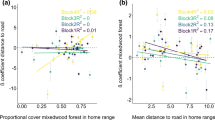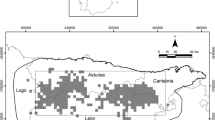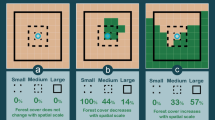Abstract
Efforts in isolating the relative effects of resources and disturbances on animal-distribution patterns remain hindered by the difficulty of accounting for multiple scales of resource selection by animals with seasonally dynamic drivers. We developed multi-scale, seasonal models to explore how local resource selection by the threatened forest-dwelling woodland caribou (Rangifer tarandus caribou) was influenced by both broad-scale landscape context and local resource heterogeneity in the intensively managed region of Charlevoix, Québec, Canada, located on the southern border of the North American caribou range. We estimated resource selection functions using 23 GPS-collared caribou monitored from 2004 to 2006 and landscape data on vegetation classes, terrain conditions, and roads. We found evidence of thresholds in road “proximity” effects (up to 1.25 km), which underscores the importance of including landscape context variables in addition to locally measured variables, and of fitting seasonal-specific models given temporal variation in the magnitude of selection and optimal scale of measurement. Open lichen woodlands were an important cover type for caribou during winter and spring, whereas deciduous forests, wetlands, and even young disturbed stands became important during calving and summer. Caribou consistently avoided roads and rugged terrain conditions at both local and landscape levels. Landscape context fundamentally constrains the choices available to animals, and we showed that failing to consider landscape context, or arbitrarily choosing an inappropriate scale for measuring covariates, may provide biased inferences with respect to habitat selection patterns. Effective habitat management for rare or declining species should carefully consider the hierarchical nature of habitat selection.

Similar content being viewed by others
References
Bolker BM, Brooks ME, Clark CJ et al (2009) Generalized linear mixed models: a practical guide for ecology and evolution. Trends Ecol Evol 24:127–135
Boscolo D, Metzger JP (2009) Is bird incidence in Atlantic forest fragments influenced by landscape patterns at multiple scales? Landscape Ecol 24:907–918
Boyce MS, Vernier PR, Nielsen SE et al (2002) Evaluating resource selection functions. Ecol Model 157:281–300
Boyce MS, Mao JS, Merrill EH et al (2003) Scale and heterogeneity in habitat selection by elk in Yellowstone National Park. Ecoscience 10:421–431
Cabeza M, Araujo MB, Wilson RJ et al (2004) Combining probabilities of occurrence with spatial reserve design. J Appl Ecol 41:252–262
Courbin N, Fortin D, Dussault C et al (2009) Landscape management for woodland caribou: the protection of forest blocks influences wolf-caribou co-occurrence. Landscape Ecol 24:1375–1388
Courtois R (2003) La conservation du caribou forestier dans un contexte de perte d’habitat et de fragmentation du milieu (In French). Ph.D. Thesis. Université du Québec à Rimouski, PQ, Canada
Courtois R, Ouellet J-P, Gagné B (1998) Characteristics of cutovers used by moose (Alces alces) in early winter. Alces 34:201–211
Courtois R, Ouellet J-P, Dussault C et al (2004) Forest management guidelines for forest-dwelling caribou in Quebec. Forest Chron 80:598–607
Cushman SA, McGarigal K (2004) Patterns in the species-environment relationship depend on both scale and choice of response variables. Oikos 105:117–124
Desautels R, Després R, Dufresne F et al (2009) Voirie forestière (In French). In Ordre des Ingénieurs forestiers du Québec. Manuel de Foresterie, 2ème édn. Ouvrage collectif, Éditions Multimondes, Québec, pp 1187–1244
Duchesne M, Côté SD, Barrette C (2000) Responses of Woodland caribou to Winter ecotourism in the Charlevoix Biosphere Reserve, Canada. Biol Conserv 96:311–317
Dussault C, Courtois R, Huot J et al (2001) Influence of satellite geometry and differential correction on GPS location accuracy. Wildl Soc Bull 29:171–179
Dyer SJ, O’Neill JP, Wasel SM et al (2001) Avoidance of industrial development by woodland caribou. J Wildl Manage 65:531–542
Dyer SJ, O’Neill JP, Wasel SM et al (2002) Quantifying barrier effects of roads and seismic lines on movements of female woodland caribou in northeastern Alberta. Can J Zool 80:839–845
Faille G, Dussault C, Ouellet J-P et al (2010) Range fidelity: the missing link between caribou decline and habitat alteration? Biol Conserv 143:2840–2850
Fortin D, Fryxell JM, O’Brodovich L et al (2003) Foraging ecology of bison at the landscape and plant community levels: the applicability of energy maximization principles. Oecologia 134:219–227
Fortin D, Courtois R, Etcheverry P et al (2008) Winter selection of landscapes by woodland caribou: behavioural response to geographical gradients in habitat attributes. J Appl Ecol 45:1392–1400
Frid A, Dill L (2002) Human-caused disturbance stimuli as a form of predation risk. Conserv Ecol 6:11
Gillies CS, Hebblewhite M, Nielsen SE et al (2006) Application of random effects to the study of resource selection by animals. J Anim Ecol 75:887–898
Graf RF, Bollmann K, Suter W et al (2005) The importance of spatial scale in habitat models: capercaillie in the Swiss Alps. Landscape Ecol 20:703–717
Grand J, Buonaccorsi J, Cushman SA et al (2004) A multiscale landscape approach to predicting bird and moth rarity hotspots, in a threatened pitch pine-scrub oak community. Conserv Biol 18:1063–1077
Hins C, Ouellet J-P, Dussault C et al (2009) Habitat selection by forest-dwelling caribou in managed boreal forest of eastern Canada: evidence of a landscape configuration effect. Forest Ecol Manage 257:636–643
Houle M, Fortin D, Dussault C et al (2010) Cumulative effects of forestry on habitat use by gray wolf (Canis lupus) in the boreal forest. Landscape Ecol 25:419–433
James ARC, Stuart-Smith AK (2000) Distribution of caribou and wolves in relation to linear corridors. J Wildl Manage 64:154–159
James ARC, Boutin S, Hebert DM et al (2004) Spatial separation of caribou from moose and its relation to predation by wolves. J Wildl Manage 68:799–809
Johnson CJ, Gillingham MP (2005) An evaluation of mapped species distribution models used for conservation planning. Environ Conserv 32:117–128
Johnson CJ, Parker KL, Heard DC (2001) Foraging across a variable landscape: behavioral decisions made by woodland caribou at multiple spatial scales. Oecologia 127:590–602
Johnson CJ, Parker KL, Heard DC et al (2002) A multiscale behavioral approach to understanding the movements of woodland caribou. Ecol Appl 12:1840–1860
Johnson CJ, Boyce MS, Mulders R et al (2004) Quantifying patch distribution at multiple spatial scales: applications to wildlife-habitat models. Landscape Ecol 19:869–882
Johnson CJ, Nielsen SE, Merrill EH et al (2006) Resource selection functions based on use-availability data: theoretical motivation and evaluation methods. J Wildl Manage 70:347–357
Kie JG (1999) Optimal foraging and risk of predation: effects on behavior and social structure in ungulates. J Mammal 80:1114–1129
Levin SA (1992) The problem of pattern and scale in ecology. Ecology 73:1943–1967
Li H, Wu J (2007) Landscape pattern analysis: key issues and challenges. In: Wu J, Hobbs RJ (eds) Key topics in landscape ecology. Cambridge University Press, Cambridge, pp 39–61
Li X, Li D, Ma Z et al (2006) Nest site use by crested ibis: dependence of a multifactor model on spatial scale. Landscape Ecol 21:1207–1216
Manly BFJ, McDonald LL, Thomas DL et al (2002) Resource selection by animals: statistical design and analysis for field studies, 2nd edn. Kluwer Academic Publishers, Dordrecht
Manning AD, Lindenmayer DB, Barry SC et al (2006) Multi-scale site and landscape effects on the vulnerable superb parrot of south-eastern Australia during the breeding season. Landscape Ecol 21:1119–1133
McLoughlin PD, Dunford JS, Boutin S (2005) Relating predation mortality to broad-scale habitat selection. J Anim Ecol 74:701–707
Meyer CB, Thuiller W (2006) Accuracy of resource selection functions across spatial scales. Divers Distrib 12:288–297
Millspaugh JJ, Skalski JR, Kernohan BJ et al (1998) Some comments on spatial independence in studies of resource selection. Wildl Soc Bull 26:232–236
Nellemann C, Vistnes I, Jordhoy P et al (2003) Progressive impact of piecemeal infrastructure development on wild reindeer. Biol Conserv 113:307–317
Nielsen SE, Stenhouse GB, Boyce MS (2006) A habitat-based framework for grizzly bear conservation in Alberta. Biol Conserv 130:217–229
Potvin F, Breton L (1988) Use of a net gun for capturing white-tailed deer, Odocoileus virginianus, on Anticosti Island, Québec. Can Field-Nat 102:697–700
Rempel RS, Elkie PC, Rodgers AR et al (1997) Timber-management and natural-disturbance effects on moose habitat: landscape evaluation. J Wildl Manage 61:517–524
Rettie WJ, Messier F (2000) Hierarchical habitat selection by woodland caribou: its relationship to limiting factors. Ecography 23:466–478
Rettie WJ, Sheard JW, Messier F (1997) Identification and description of forested vegetation communities available to woodland caribou: relating wildlife habitat to forest cover data. Forest Ecol Manage 93:245–260
Schadt S, Revilla E, Wiegand T et al (2002) Assessing the suitability of central European landscapes for the reintroduction of Eurasian lynx. J Appl Ecol 39:189–203
Seip DR (1992) Factors limiting woodland caribou populations and their interrelationships with wolves and moose in Southeastern British-Columbia. Can J Zool 70:1494–1503
Senft RL, Coughenour MB, Bailey DW et al (1987) Large herbivore foraging and ecological hierarchies. Bioscience 37:789–799
Thompson CM, McGarigal K (2002) The influence of research scale on bald eagle habitat selection along the lower Hudson River, New York (USA). Landscape Ecol 17:569–586
Thornton DH, Branch LC, Sunquist ME (2011) The influence of landscape, patch, and within-patch factors on species presence and abundance: a review of focal patch studies. Landscape Ecol 26:7–18
Vistnes I, Nellemann C (2008) The matter of spatial and temporal scales: a review of reindeer and caribou response to human activity. Polar Biol 31:399–407
Wheatley M, Johnson C (2009) Factors limiting our understanding of ecological scales. Ecol Complex 6:150–159
Whittington J, St-Clair CC, Mercer G (2005) Spatial responses of wolves to roads and trails in mountain valleys. Ecol Appl 15:543–553
Wiens JA (1989) Spatial scaling in ecology. Funct Ecol 3:385–397
Wittmer HU, McLellan BN, Serrouya R et al (2007) Changes in landscape composition influence the decline of a threatened woodland caribou population. J Anim Ecol 76:568–579
Wu J (2004) Effects of changing scale on landscape pattern analysis: scaling relations. Landscape Ecol 19:125–138
Wu J (2007) Scale and scaling: a cross-disciplinary perspective. In: Wu J, Hobbs RJ (eds) Key topics in landscape ecology. Cambridge University Press, Cambridge, pp 115–142
Wu J, Loucks OL (1995) From balance-of-nature to hierarchical patch dynamics: a paradigm shift in ecology. Q Rev Biol 70:439–466
Acknowledgments
We would like to thank L. Breton, P. Dubois, J.-G. Frenette, S. Lefort, R. McNicol and S. St-Onge for capture of caribou and recovery of the GPS data. Funding for this study was provided by the Ministère des Ressources naturelles et de la Faune du Québec, the Ministère des Transports du Québec, the Fondation de la Faune du Québec, and the World Wildlife Fund. M. Leblond received a graduate scholarship from the Fonds québécois de recherche sur la nature et les technologies.
Author information
Authors and Affiliations
Corresponding author
Rights and permissions
About this article
Cite this article
Leblond, M., Frair, J., Fortin, D. et al. Assessing the influence of resource covariates at multiple spatial scales: an application to forest-dwelling caribou faced with intensive human activity. Landscape Ecol 26, 1433–1446 (2011). https://doi.org/10.1007/s10980-011-9647-6
Received:
Accepted:
Published:
Issue Date:
DOI: https://doi.org/10.1007/s10980-011-9647-6




